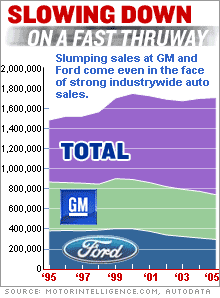|
A bright, shiny car wreck
The auto industry is actually in pretty good shape -- if you look past serious problems at GM, Ford.
DETROIT (CNNMoney.com) - If you ignore the severe problems plaguing the nation's two biggest automakers, you'll see that 2005 was a very good year for the auto industry. U.S. sales edged up to just under 17 million vehicles, the best year since 2001. Most automakers saw improved U.S. sales despite record high gasoline prices.
"Particularly if you step back and say what would we had anticipated a year ago if we had known we would have record oil prices, the fact that we had third best year in history is amazing," said Bob Schnorbus, chief economist for JD Power & Associates. The year ahead could be a good one, too, especially for the global industry. While most economists are calling for a cooling in the U.S. economy, continued solid growth is expected to keep U.S. sales solidly above the 16 million mark that would have been a sales record as recently as 1998. And with the economy picking up in Japan, and sales soaring in China, two of the world's other largest auto markets, the industry appears to be in good shape overall. But as the industry gathers in Detroit for the North American International Auto Show starting Sunday, it's tough to look past the problems at General Motors Corp. and Ford Motor Co. "You talk about autos with people that you meet, they talk about how bad the auto industry is doing because of the problems with GM and Ford," said David Lucas, vice president of auto sales tracker Autodata. "It's quite the opposite." Both automakers are losing billions on their core automotive operations, as they struggled to deal with rising health care costs for both active and retired employees and their families. Both have had their debt downgraded to junk bond status, and GM faces paying up to $12 billion in contract obligations to workers at its former parts unit, Delphi Corp., which filed for bankruptcy court protections Oct. 8. Perhaps just as serious, both saw U.S. sales fall 4 percent in the year, and they had to cut prices and raise sales incentives on their vehicles in order to keep sales from falling further. Stocks of both companies plunged in 2005, each losing roughly half of their value. GM has been plagued by questions about the possibility of filing for bankruptcy protection, despite repeated statements from its top executives that they have no such plans. While both companies have talked about their plans to introduce new products to spur sales, their immediate solutions have been to signal programs to cut deeply into their current capacity and work force. GM announced in November plans to close 12 facilities in North America and to cut 30,000 hourly jobs in the coming years, more than 20 percent of its current production staff. Ford plans to make its own restructuring plans public Jan. 23 ... and the speculation is that the cuts there will be just as deep. GM is set to meet with analysts on Thursday to give them details about the progress of its turnaround plans. But so far it has given no signal as to when it may return to profitability. So this auto show will be particularly important for GM and Ford. It's a chance for them to trumpet designs for new cars and trucks, not details of new crises and cuts. With thousands of journalists from around the world gathered in Detroit, it's a chance for them to get some relatively rare good ink. But getting that positive spin will be difficult as many of the reports, like this one, will be highlighting the ongoing problems. And the two companies' competitors obviously will be trying to generate their own excitement and buzz about their own new vehicles and design concepts. The early buzz is that it will be the DaimlerChrysler's Dodge Challenger that could be getting a lot of the attention when it is unveiled during the press days. A lot of the talk at the show will be about the crossover vehicle, the car-based sport utility vehicle that has become by far the hottest segment in the industry. Sales of crossover vehicles were up 11 percent in 2005 and have increased more than 30 percent since 2003. And the sales are generally seen coming at the expense of the traditional truck-based SUV, which has seen sales fall 12 percent since 2003. That is more bad news for GM (Research) and Ford (Research). While they have their own crossover offerings, they have relatively little in the pipeline in that segment. And the larger SUV is the segment that was a key to their profits in the past. Much of their financial problems can be traced to the declines in that segment. While gasoline and oil prices are off their post-Hurricane Katrina record highs, they are still above year-ago levels. That will bring more focus on fuel economy and gas-electric hybrid vehicles once again. Ford and GM will undoubtedly talk about their own plans for a new generation of fuel-efficient vehicles along with their efforts to move beyond gasoline to things such as fuel-cell powered vehicles. But once again, it's Japanese automakers, Toyota Motor Corp. and Honda Motor Co., which are making most of the sales of hybrid vehicles, and getting most of the attention from consumers who are thinking more about cutting what they pay at the gas pump. ___________________________ |
|

